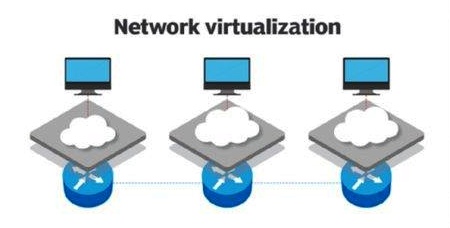What is Network Virtualization?
Network Virtualization (NV) involves transforming network resources, traditionally provided through hardware, into a software-based format. NV can integrate multiple physical networks into a single virtual network or partition one physical network into distinct and autonomous virtual networks.
With network virtualization software, administrators can relocate virtual machines across various domains without the need for network reconfiguration. The software establishes a network overlay, enabling the operation of distinct virtual network layers over the shared physical network fabric.
ad

Why Network Virtualization?
Network virtualization is reshaping the established norms governing service delivery across various domains, spanning from the software-defined data center (SDDC) to the cloud and the edge. This transformative approach shifts networks away from being static, rigid, and inefficient to becoming dynamic, agile, and optimized. In the contemporary landscape, networks are required to meet the challenges posed by cloud-hosted distributed applications and the escalating threats from cyber-criminals. Simultaneously, they must provide the speed and agility necessary for achieving quicker time-to-market for applications.
Through network virtualization, the traditional hurdles of spending days or weeks on provisioning infrastructure to support a new application become obsolete. Instead, applications can be swiftly deployed or updated within minutes, facilitating rapid time-to-value.
ad
How Does Network Virtualization Work?
Network virtualization separates network services from the underlying hardware, enabling the virtual provisioning of an entire network. This allows for the programmable creation, provisioning, and management of networks through software, while still utilizing the underlying physical network as the packet-forwarding backplane. Physical network resources, including switching, routing, firewalling, load balancing, virtual private networks (VPNs), and more, are consolidated, delivered in software, and solely require Internet Protocol (IP) packet forwarding from the underlying physical network.
The distribution of network and security services in software occurs at a virtual layer (such as hypervisors in the data center) and is “attached” to individual workloads, such as virtual machines (VMs) or containers, in alignment with predefined networking and security policies for each connected application. As workloads are relocated to different hosts, the associated network services and security policies move with them. Additionally, when new workloads are generated to scale an application, pertinent policies are dynamically applied to these workloads, ensuring enhanced policy consistency and network agility.
Benefits of Network Virtualization
Network virtualization enables organizations to make significant strides in speed, agility, and security by automating and streamlining numerous processes involved in operating a data center network and handling networking and security in the cloud. The following are key benefits of network virtualization:
- Decrease network provisioning time from weeks to minutes.
- Attain higher operational efficiency through the automation of manual processes.
- Independently place and relocate workloads without being constrained by physical topology.
- Enhance network security within the data center.
Types of Network Virtualization
Network Virtualization
Network virtualization is a method that consolidates the existing resources within a network by partitioning the available bandwidth into distinct channels, each being separate and identifiable.
Server Virtualization
This method involves concealing server resources, mimicking physical servers by altering their identity, numbers, processors, and operating frameworks. This alleviates users from the continuous management of intricate server resources and provides a wealth of resources for sharing and utilization, with the ability to expand them as needed.
Data Virtualization
In this cloud computing virtualization approach, technical details commonly associated with data management, such as location, performance, or format, are abstracted. Instead, the focus is on broader access and increased resilience directly aligned with business requirements.
Application Virtualization
Software virtualization in cloud computing abstracts the application layer, detaching it from the operating framework.
FAQ’s
What is Network Virtualization, and why is it important?
Network Virtualization (NV) is a technique that transforms traditional hardware-based network resources into a software-based format. It is crucial for enhancing flexibility, agility, and security in service delivery across different domains.
How does Network Virtualization benefit organizations?
Network Virtualization automates processes, reducing network provisioning time from weeks to minutes. It enhances operational efficiency, enables independent workload placement, and improves overall network security within data centers.
What challenges does Network Virtualization address in the current IT landscape?
Network Virtualization addresses the challenges of static and inefficient networks by adapting to the demands of cloud-hosted applications and mitigating cybersecurity threats.
How does Network Virtualization work in practical terms?
Network Virtualization separates network services from hardware, allowing programmable creation and management through software. It overlays virtual network layers on a shared physical network, consolidating resources like switching, routing, and firewalling.
Can virtual machines be moved across different domains with Network Virtualization?
Yes, with Network Virtualization software, administrators can relocate virtual machines across various domains without the need for extensive network reconfiguration.
What role does network overlay play in Network Virtualization?
Network overlay is established by the software, allowing the operation of distinct virtual network layers over the shared physical network fabric.
How does Network Virtualization contribute to faster time-to-market for applications?
By eliminating the traditional hurdles of infrastructure provisioning, Network Virtualization allows applications to be swiftly deployed or updated within minutes, facilitating rapid time-to-value.
What are the key benefits of Network Virtualization?
The benefits include decreased network provisioning time, higher operational efficiency, independent workload placement, and improved network security within data centers.
What types of virtualization are associated with Network Virtualization?
Network Virtualization encompasses various types, including Server Virtualization, Data Virtualization, and Application Virtualization.
How does Data Virtualization differ from other types of virtualization?
Data Virtualization abstracts technical details related to data management, emphasizing broader access and increased resilience aligned with business requirements.
Conclusion
Network Virtualization is a transformative solution revolutionizing service delivery across data centers, the cloud, and edge computing. By untethering network services from hardware, it introduces agility and efficiency. This approach, addressing challenges in provisioning speed and security, positions Network Virtualization as a key driver toward a future of flexible, efficient, and secure network management.
ad


Comments are closed.